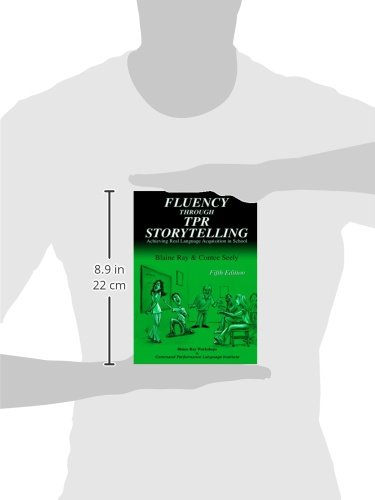Customer Services
Copyright © 2025 Desertcart Holdings Limited
Desert Online General Trading LLC
Dubai, United Arab Emirates



Fluency Through TPR Storytelling
A**R
Very confusing teaching method
I am a volunteer ESL teacher at my church. I'm a native english speaker and have learned Portuguese (and now learning 2 more languages). I love language learning. I decided to volunteer to teach an ESL class of Brazilian learners. I did an intense study of classroom language teaching methods online. I needed to learn how ESL is taught. I naviely thought that with all of the succesful polygots on youtube and Steven Krashen's research, that there would be a wealth of good methods and materials avaible. How wrong I was! I was less than impressed with the usual heavy grammar instruction, role playing, forced speaking exercises and 'games' that don't look fun for anyone. I stumbled onto this TPRS. The method didn't make much sense to me. So I've read dozens of blogs, I watched dozens of youtube videos. I still couldn't make sense of it, so I ordered this book. But it hasn't helped clear things up.So from my understanding...1. Teachers don't need to do any prep work (sounds attractive to me since I easily spend 12-13 hours prepping per hour of class)2. The teachers 'ask for a story' from the students. Are these questions in the target language or their native language? Not clear to me. If its the target language...how do the students understand?? If its their native language, thats alot of wasted classtime.3. Why are the stories so strange? I have working adults, who are very busy and are sacrificing their evenings to learn english, so eventually they will be successful in the USA and will be able to take care of their families. This is a serious responsibilty for an ESL teacher. The students aren't going to enjoy silly stories about Madonna living on the moon!4. So you come up with this silly story in class, how on earth do the students read this story later? Is there somebody taking notes during class?5. I resent the idea that if a teacher isn't successful using this method that they are the ones at fault NOT the method!6. I resent the push for teachers to drop $300 for a weekend of instruction, TPRS Workshop....(this isn't including the cost of gas, hotel, food etc). If the authors of this book can't teach people this method in writing, why would a live demonstration be any different?7. I want to hear what the students think of this method. I see an awful lot of back slapping and declaring themselves Master Teachers, but it's what the students think that really matters. Can a student of this class go out and socialize and make friends in this language? Can they function in this language?8. I resent the straw man argument that this book makes...if you don't like this wonderful method than you're an old stoogy language teacher hanging onto old methods.I don't recommened this book.
T**N
I was still happy to pay for another copy
I lost my first version of this book and had to buy another. There are not many books I would buy again, but nothing comes close to TPR storytelling when I am teaching TEFL in an environment without many resources. All we really need are ourselves and the ideas in this book. I probably have the ideas memorized by now, but that doesn't seem to matter. I was still happy to pay for another copy.
O**E
Make sure to get the current, seventh edition. You'll be glad you did.
TPR Storytelling is simply the best way to teach foreign languages for the first two or three years of instruction. It consists, not of a prescriptive program, but of a set of skills that can be used to interact with a group of students. It really is a set of skills. Nobody's going to master them in a month, or even a year. However, they are so superior to traditional language instruction methods that even with partly-mastered skills, the instructor will witness immediate improvements over whatever they were using before.After that foundation is laid, fourth year and subsequent year instruction can fall back to normal language development methods used in native and second language development.The current edition is the seventh edition. It's well worthwhile seeking this one out, since it contains much new materials, and, most importantly, three chapters of clear introduction about what TPR Storytelling is all about.
T**A
Promoting a product -- very biased and badly written
Book is badly written with much redundancy. Cult-like in its exaltation of TPRS as the one and only way to teach language. Not written by an academic, that's clear. Promoting a product.
S**A
Five Stars
Great for English and World Language teachers.
E**C
Five Stars
practical for a teacher
W**R
Me encanta!
I have been fascinated with language acquisition theories for a while now. I am very pleased with this focus on approaching language naturally and holistically. This book is a great resource for anyone wanting to advance their language skills or strengthen their language instruction. The methods focus on reducing the anxieties associated with language learning--imagine confidence in speaking instead of the anxiety of self-censorship that results from trying to think in the native language and translating simultaneously.I strongly recommend this book.
M**R
Great new edition of a most valuable language teaching tool.
Thanks Blaine and Contee for this new edition. The great updates on the changes and developments in TPRS devloped in recent years in this edition will help me to continue to improve my teaching.
Trustpilot
1 week ago
1 month ago